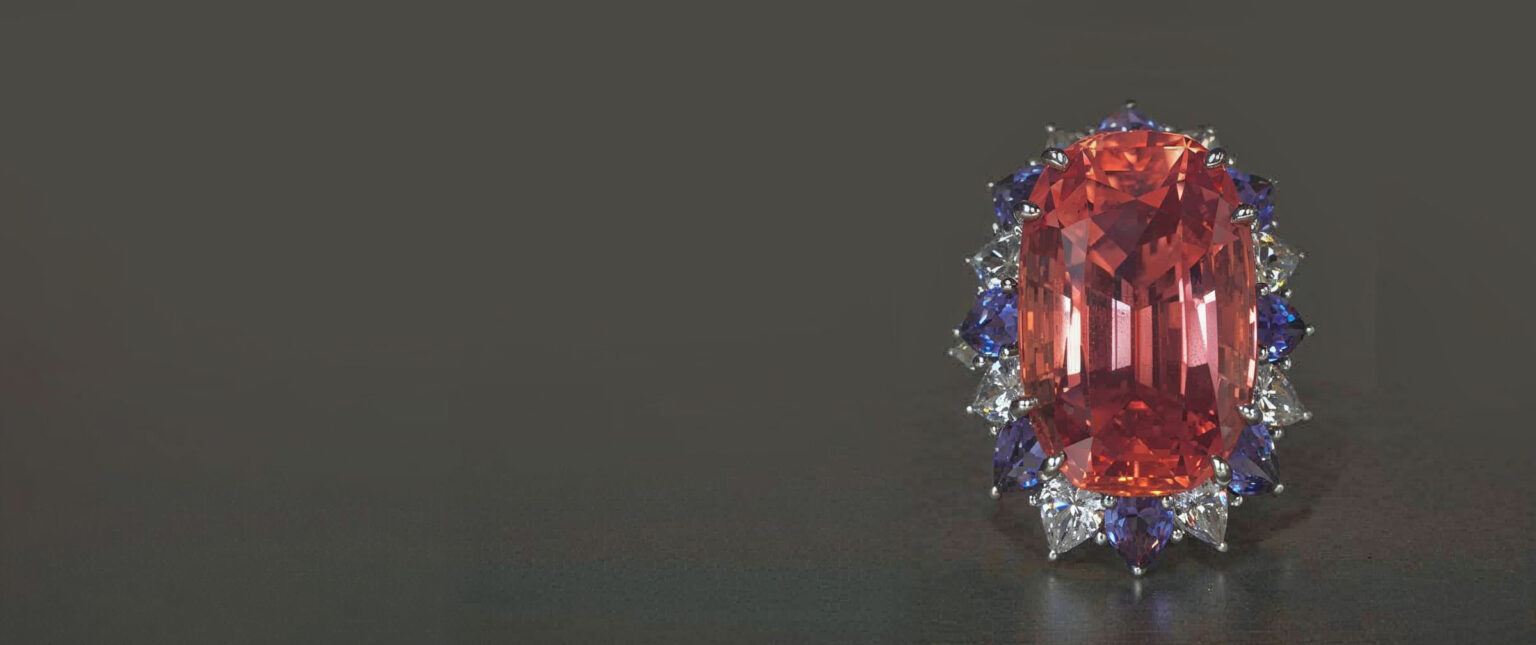It is almost a macho obligation these days for precious stone dealers to say they are versed in padparadscha sapphire, the rarest and most-prized fancy corundum in the world. Yet one of the few acknowledged experts on this gem in America, New York lapidary Reggie Miller, Reginald C. Miller Inc., says that after nearly 25 years’ experience buying padparadschas, he has seen less than 10 that qualify as fine specimens of this stone. “Padparadscha’ is one of the most abused gem names I can think of,” Miller says. “In fact, Ceylonese dealers use it as a catch-all term for any sapphire that can’t be considered ruby.”
Given the paucity of true padparadschas, it is easy to understand why there is so much confusion in the trade about this gem. The confusion has widened in recent years as fancy sapphires in general have zoomed in popularity. And it will grow worse if more dealers seek acceptance for use of the term “padparadscha” in conjunction with marketing a certain kind of East African fancy sapphire. Already some West Coast dealers claim that a select few of these African stones are indistinguishable from their Asian counterparts. That’s news to the East Coast. “I have yet to see an African fancy sapphire that could be called padparadscha,” Miller insists. “I’m anxious to see one.” Meanwhile an important question before the trade remains: Just what is padparadscha?
The answer has much to do with what it’s not. This process of elimination helps to narrow the number of candidates for the padparadscha category and thus reduce confusion. But we want at the outset: Padparadscha is a gem that requires great savvy to buy. Those who lack it should find a dealer with good credentials in the fancy sapphire area.
From Sanskrit to Slang
The trade can be partially excused for its liberalness with the padparadscha label. In the last 100 or so years, the term has undergone several important shifts—or, better yet, refinements—in meaning. Those shifts are detailed in a superb—some say definitive—article on padparadscha by the eminent gemologist Robert Crowningshield published in the Spring 1983 issue of Gems and Gemology.
Apparently, the term “padparadscha” is derived from an ancient Sanskrit word (padmaraga) for the lotus flower and its color. From there it makes its way into Sinhalese (padmaragaya) and ultimately into German (padparadschan). When it finally surfaces as a term applied to gems (Crowningshield dates its earliest usage as such to 1849), it carries a different color connotation than it does now.
A century ago, the word we know today as padparadscha referred to a ruby sub-grouping and was used to describe a pinkish-red corundum. By the time Max Bauer, whom Crowningshield calls “the dean of gemological writers,” pronounces on the gem in 1909, it has become a “reddish-yellow” fancy sapphire. In 1932, Bauer gives the gem its modern spelling and modified his description to “orange to a reddish yellow.” Today, of course, the term is more specifically associated with a pinkish-orange fancy sapphire. The colors red and yellow are rarely, if ever, used at all.
The term “padparadscha” has not only been restricted in terms of color scope but also in terms of tone and origin. Tone, as Crowningshield says, “should be limited to light to medium” ones. Origin, of course, is strictly Ceylonese. However, just because the term padparadscha seems to have changed meaning over the years, it is doubtful that the centuries-old aesthetic ideal for this stone has. Indeed, Miller believes that these changes really represent “a pinpointing of meaning” so that the term more nearly mirrors the mental image that experts have of padparadscha. In this way, the term lends itself much less to abuse. “There was always a very narrow margin of acceptable color for padparadscha,” Miller says.
Of Salmon and Sunsets
Because the jewelry industry has not yet adopted any standardized color measurement system, there is no way to precisely quantify that amount of orange and pink, plus their total strength, that constitutes padparadscha color. Lacking such measurements, dealers must resort to metaphor to describe bottom-line padparadscha color.
According to Judy Mayfield, Mayfield’s Inc., Los Angeles, the term padparadscha conjures up images of “luscious lox (salmon) slices.” These metaphoric descriptions eliminate from consideration as padparadscha many of the reddish-orange and brownish-orange fancy sapphires often proffered to the public as such.
In general, true padparadschas must have the distinctive but delicate pinkish-orange sunset/salmon-flesh color in just the right balance and intensity. To get that color, jewelers will probably have to look for stones in excess of 5 carats. “Padparadscha need a certain amount of body mass to get its full color going,” explains Miller. “Most of the fine stones I’ve seen are at least 5 and often 10 carats or more.”
In addition, Miller notes, stones will have to be fairly clean. Visible inclusions can dull and flatten even the finest padparadscha color. Dealers want vitality as much as proper hue. All of this translates into a minimum of $5,000, probably closer to $10,000, per carat for a clean, well-cut, true-color Ceylonese padparadscha. What are called “African padparadschas” will cost $2,000 to $3,000 per carat.
“The so called ‘African padparadschas’ from the Umba River region of Tanzania have far more brown and orange than true Ceylonese padparadschas,” says Josh Hall, Pala International, Fallbrook, Calif. “Although they are beautiful as fancy sapphires, they lack the delicate balance of pink and orange that means so much in padparadscha.”
Nevertheless, there seems to be growing jeweler acceptance of certain African fancy sapphires as padparadschas. Indeed, we recently visited an American Gem Society store in Philadelphia whose proprietor, one of the savviest gem buyers we know, proudly showed us a dark brownish pink-orange sapphire from Umba when we asked to see a padparadscha. When we dismissed the stone as an African fancy sapphire and not a true padparadscha, the jeweler protested, insisting we were wrong. A few years back, the same jeweler, we’re convinced, would never have allowed an African fancy sapphire to substitute for a true Sri Lankan padparadscha.
Either we’re being too prissy or jewelers are getting too desperate for something to sell as padparadscha. If it’s the latter, we urge such jewelers to live with desperation. As Allan Mayfield, Mayfield’s Inc., puts it: “Fine padparadscha is far rarer than either fine Kashmir sapphire or Burma ruby. We’re talking about a true Rembrandt among gemstones.”
Please note: this profile was originally published in 1988 in Modern Jeweler’s ‘Gem Profiles: The First 60’, written by David Federman with photographs by Tino Hammid.
The approximate 30-carat padparadscha sapphire shown in the header image is courtesy of R. Esmerian Inc., New York.






